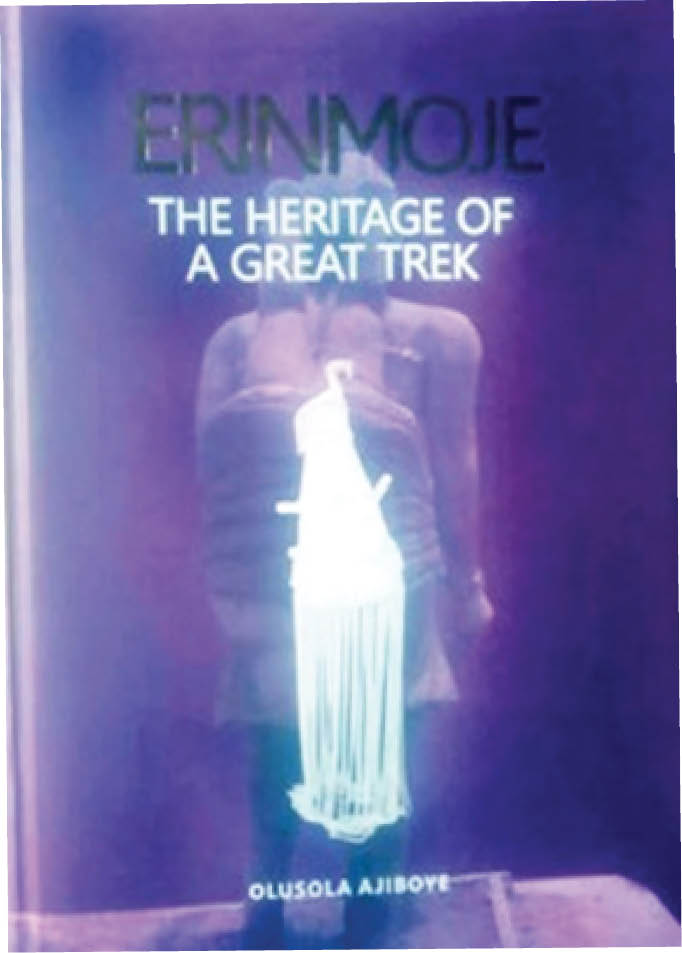Business and Brands
Erin People Find A Home In ‘Erinmoje’
Erin People Find A Home In ‘Erinmoje’

Title: Erinmoje: The Heritage of a Great Trek Author: Olusola Ajiboye Reviewer: Dr. Abimbola Adesoji ‘Erinmoje: The Heritage of a Great Trek’ is an…
Title: Erinmoje: The Heritage of a Great Trek
Author: Olusola Ajiboye
Reviewer: Dr. Abimbola Adesoji
‘Erinmoje: The Heritage of a Great Trek’ is an effort to document for posterity the account of origins and notable developments in the various Erin kingdoms culminating into the establishment of Erin Osun.
The significance of this book derives from the fact that it has put together in a volume, the traditions and histories of the Erin people. This becomes pertinent given that many of our traditions are being lost and many children do not know anything about traditions, culture and customs of their people again.
When it is recognized that our culture, tradition and history are a symbol of our identity, then one wonders what kind of identity our children would have and what will become of our communities with successive generations. That is why this volume is highly commendable having placed the author in the category of the likes of J.A. Ademakinwa, M.A Fabunmi, M.O. Fasogbon of Ile-Ife, S.O.S Atayero J.D.E. Abiola and J.A Babafemi of Ilesa, K.A Ajisafe of Abeokuta, S.O, Bada of Oyo J.U. Egharevba of Benin, M.C. Adeyemi of Ondo and the celebrated Samuel Johnson of Oyo. These people were amateur historians, who buoyed by patriotism documented the history of their communities, and which despite their imperfections have remained reference points in the history of those communities till the present.
More importantly, the book has placed Erin-Osun and by extension the Erin kingdoms or communities on the historical map, which is getting expanded by the day.
Chapter one deals with the origin and migration of Erin people from Ile-ife led by their progenitor, Odumosa, prince and heir to Obalufon Alayemore, the third Ooni of Ife. It establishes clearly that the history of Erin Kingdoms was characterized by migrations hence the name Erin. Causes of migration ranged from wars, chieftaincy and succession disputes and quest to find new lands in line with the mandate given by Oduduwa, their ancestor. Aiding the growth of the settlements were such factors as the will to survive, their ingenuity, and abundance of richly watered land (like the Olumirin Water Falls) and spirit of accommodation, the acceptance of Odumasa by confederation of Erinmoje, Erin-Sare, Eku-Apa, Gbagba and Afolu.
Significantly, their settlement in different places notwithstanding, each section holds on to the common ancestry and heritage. Obvious therefore in the emergence of Erinmoje is the need for cultural integration to reinforce the cord of unity despite the long period of migrations and settlement in different parts of the Yoruba country.
Particular reference is made to Idi-Ayo where Odumosa was crowned. Also significant was that these migrations took place between 1200 and 1225 A.D. when history recorded several waves of migration out of Ile-Ife.
Chapter Two relates the role of Odumosa Apaayan in the evolution of the Erin communities. Odumosa descended from Obalufon Alayemore who reigned as Ooni in Ile-Ife following the demise of Ogbogbodinrin. Alayemore left Ile-Ife with Odumosa following the sudden return of Oranmiyan Odede from his military expedition. Alayemore founded Efon-Alaaye where he apparently died, thus linking the Erin communities with Efon-Alaaye and Ido-Osun.
So Odumosa accompanied by his son Alawode Arebiope and Alapa, his brother moved on to found the different Erin communities form Erintadogun, Erinmo, Erin-Ijesha to Erin-Oke all of which existed for longer period before Erin-Ile and Erin-osun, the challenges they faced notwithstanding.
But the link is the tradition of common origin, premised on culture, traditional festivals and deities. Whereas Erintadogun depicts a settlement founded after seventeen days of trek, Erinmo relates to a settlement built with palm fronds, Pertinent was the dogged determination of Odumosa aided by environmental or locational factors.
Chapter Three identifies symbols and cultural traits which are manifestation of the common history of the Erin communities with which they are identified. Ogun and Obalufon were the commonest with similar mode of worship in the different communities, an indication of their common heritage and a binding cord of unity among them.
In particular, the Obalufon festival characterized by a primordial but largely ceremonial wrestling bout/contest between Elerin and Aworo Obalufon and a supporting wrestling bout of three lads is representative/symbolic of the struggle of Odumosa and the great subjects. The identification of other communities with Erin in the celebration of Obalufon is a further proof of the close links with them.
Of all the Erin communities, two stand out, not only in terms of their relatively recent history but also in terms of their very close affinity. The history of Erin-Ile and Erin-Osun therefore form the crux of chapters Four and Five.
Chapter Four identifies the place of three great hunters who were aborigines in the consolidation of Erin-Ile. These were Olowe, Gbagba and Afolu that Odumosa must have related with. Only Olowe, credited to have disappeared into the bowels of the earth, characteristic of a similar myth of disappearance in other parts of Yorubaland, was discussed in little details.
Olowe’s spirit was used to incite fear in neighboring communities thus guaranteeing Erin-Ile’s peace. Elerinjare came into being when Adamu, a Nupe war leader, was defeated by Elerin-Ile while Erinmope which grew as an independent town with both contributing to the expansion of Erin communities. Despite her resistance, Erin-Ile was eventually evacuated due to the Fulani rampages leading to the establishment of Erin-Papa in the Savannah.
Chapter Five discusses the growth of Erin-Osun, following the permission granted by Balogun Ajayi Osungbekun to Ayoka Oyagbodun to settle in the grassland originally called Erin-Papa but now known as Erin-Osun. Erin-Osun which shares affinity with other Erin communities is divided into five quarters namely Oke-Erin, Oke-Ila, Ehin-Igbo, Oke-Afolu and Oke-Ore, with other communities which were accommodated being fully integrated. Erin has been ruled by six kings since inception and has witnessed tremendous developments due to the versatility, commitments and patriotism of these rulers.
The subject of physical and socio-economic transformation is the focus of chapter Six. In terms of buildings, the community has witnessed transformation from the prevalence of long rectangular houses built with muds and located in family compounds, to new structures particularly starting from 1944 when the first corrugated house with mansard windows was built.
It was this development that also saw the old palace structure with traditional Kobi gave ways to a new one. These developments spanned the reigns of Elerins Oyagbodun Ayoka I, Olaojo (Who eventually returned to Erin-Ile), Abegunde, Adewuyi, David Oyebode Adeosun and Omoloye Oyagbodun II. Both Abegunde and Adewuyi came from Abegunde ruling house and reigned for six months and 43 years respectively. Elerins Ayoka I, Adewuyi and Adeosun and Oyagbodun II were credited with specific achievements with the reigning monarch being credited with greater achievements having reigned in modern time.
Chapter Seven traces the evolution and growth of Town Unions in Erin-Osun to the formation of Bajepade society in 1914 to provide opportunity for Erin-Osun indigenes resident in Ghana, to contribute to the socio-political and economic development of their community. Its transformation to Egbe Atunluse Erin and later to Erin progressive Union was pertinent, being indicative of the various developments that had influenced the Union and its responses to those developments. Without gainsaying, the groups’ contributions to infrastructural developments are tremendous.
The remaining chapter chronicles the life, times, perspectives and reflections of dramatis personae, both living and dead, who had invaluable contributions to the sustenance of the legacy of development that the history of Erin-Osun has come to epitomize. In a similar manner, the chapter on the interaction of the author with Kabiyesi, Oba omoloye Oyagbodun II gives a deep insight into his personality characterized by uncommon humility, vision, mission and philosophy.
These features have remained his great assets and sustaining factors in his quest for the transformation of his beloved community. There is also an appendix made up of glossary of names, places and their meaning as well as other relevant notes.
In all, the book has opened a vista in the history of Erin communities generally and Erin-Osun in particular. Beyond beaming a light on the hitherto relatively unknown history of the Erin communities, its ability to provoke thoughts and generate more studies is not in doubt. I therefore commend once again the initiate of the author and the support and the drive of the community to have its history documented for now and posterity.
It is in a similar manner that I heartily recommend the book to all indigenes, inhabitants and friends of the Erin communities, community leaders, academics and the general public.
Dr. Abimbola Adesoji is Associate Professor, Dept. of History, Obafemi Awolowo University, Ile-Ife


 Top Stories23 hours ago
Top Stories23 hours agoBreaking: Abuja Stampede: 10 people including children feared de3d as they scramble for palliative…

 Top Stories23 hours ago
Top Stories23 hours agoBreaking: Okija Stampede: Many Feared De3d @ Nestoil Obi Jackson’s Yuletide Event

 News5 hours ago
News5 hours agoNigerian Emergency Agency NEMA Puts All Offices On Alert Over Fatal Stampedes

 Sports5 hours ago
Sports5 hours agoCAF Made Me Believe I Won – Achraf Hakimi

 Politics5 hours ago
Politics5 hours agoWe Will Bury PDP, Ibori’s Daughter Blows Hot

 Sports5 hours ago
Sports5 hours agoOleksandr Usyk defeats Tyson Fury to tetain heavyweight title

 Top Stories6 hours ago
Top Stories6 hours agoEmefiele: EFCC secures final forfeiture of 1.925 hectares of landed property linked to former CBN Governor







